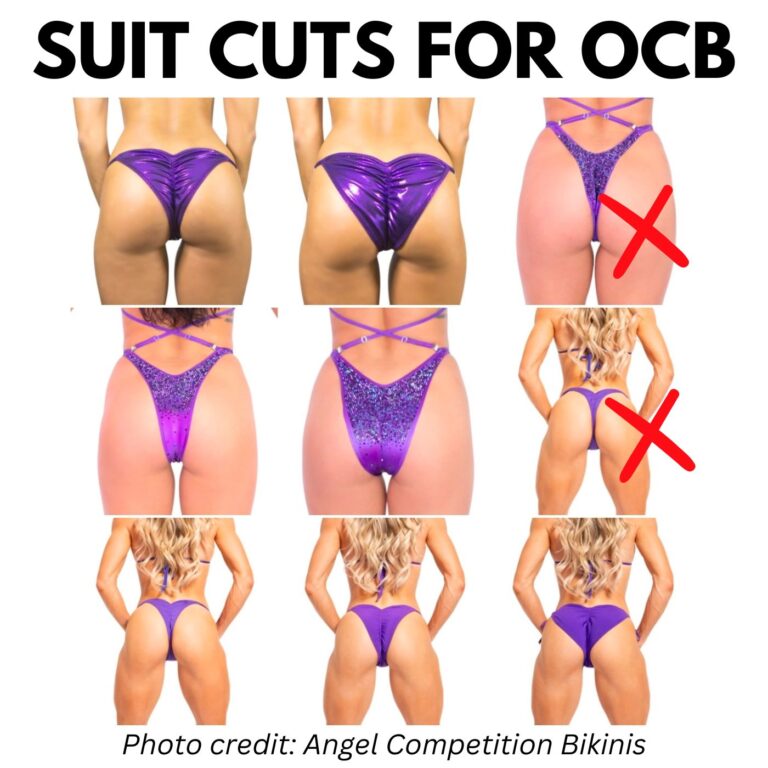Bikini Guidelines



Bikini competitions consist of 2 parts: Group Comparisons, which are scored and Individual Presentations, which are not scored.
JUDGING CRITERIA
The Bikini desired look is achieved by presenting a lightly muscled and not overly lean or hard appearing physique as compared to Figure, Wellness, or Women’s Physique. Bikini judging is based on an overall healthy, toned body with good symmetry, fullness, balance, shape and proportion. Bikini competitors should not display deep muscle separation, muscle striations or an abundance of muscle size. Excessive muscularity, striations and vascularity will be marked down. A bikini physique should display some fullness and roundness in the deltoids, some development with some fullness in the quadriceps and hamstrings and full, round, firm glutes. The abdominal region should show some muscularity but not a deeply etched or vascular appearance. The back should show development without being overly dense or wide. Competitors should perform proper posing and exhibit poise and confidence.
Bikini Symmetry: Streamlined hourglass physique that is balanced from top to bottom.
Definition: Toned, displaying some splits between the major muscle groups, but no inner detail. For example, there should be a split between quads and hamstrings, but no detail with in hamstrings, glutes or quadricep lines. Abdominal definition is acceptable, but there should not be vascularity or a deeply etched 6-pack. Bikini athletes should not exhibit muscle striations.
Size: Bikini competitors should have an athletic build and look like they train with weights. They should show some shoulder development and back muscularity without excessive density. Legs should have muscle in the glutes, quads, hamstrings and calves to give them a streamlined shape, but should not be overly developed or muscular. Glutes should be firm, full, and round.
Group Comparisons
When athletes enter the stage, they will be assembled in a line on the front of the stage and stand in their front pose. The head judge will direct competitors in a class to perform half turns and walk to the front and back of the stage. This portion of the event is judged. Not performing poses in the manner specified in the guidelines may result in lower scoring from judges. When in the back pose, bikini athletes should pull long hair aside to avoid obstructing view of the back in the rear pose. At any time, the head judge may request competitors switch places on stage. Athletes should listen for their number, raise their hand if called, and look for the other competitor to raise their hand. When called, competitors should then walk respectfully over to the other location and resume their posing position. Please note that in the OCB, an athlete’s location on the stage is not an indicator of placement.
Front Pose
Back Pose
BIKINI WALKS
Bikini is the only category where competitors are asked to walk to the front and rear of the stage. While bikini athletes are walking, judges are evaluating how the physique looks and moves compared to others as well each athlete’s stage presence. Athletes will enter the stage together as a class, stand on a pre-marked line, and immediately get into their front pose. The head judge will ask the athletes to turn and face the back of the stage, hold their pose, and direct them to walk toward the back of the stage. Once they reach the back of the stage, they will hold their back pose. When directed, they will make a half turn and face the front towards the judges. They will hold their front pose until asked to walk to the front of the stage. This sequence may be repeated a number of time until all of the judges have scored the athletes.Individual Presentations
The individual presentation portion is the stage walk. The individual presentation is not factored into placement scoring. At the promoter’s discretion, walks may be performed in a “I” or “T” formation. Some events will use house music, while other events may allow competitors to submit their own music. If you are not sure which type of walk or music offerings are being offered at a particular event, read the event registration details or contact the event promoter directly.
“I” Walk – Competitors walk directly to the rear center of the stage, which will be marked with an “X.” They will pause briefly in a pose of their choice, then walk directly to the front center stage, which will also be marked with an “X.” Here they will perform quarter or half turns with poses of their choice to provide a full view of their physique. They will then exit the stage. “I” walks are performed to house music. Athletes should be prepared to enter and exit from either side of the stage as different venues have different stage layouts.
“T” Walk – Competitors will be given 30-60 seconds (times will vary depending on the event) to pose and perform to music. Competitors will walk directly to the rear center of the stage, which will be marked with an “X.” They will pause briefly in a pose of their choice, then walk directly to front center stage, which will also be marked with an “X.” Here they will perform quarter or half turns with poses of their choice to provide a full view of their physique. To form the “T,” competitors will then walk to the left or right corner of the stage where there will be an “X” marked for them to pause and strike a pose. They will then cross to the other corner of the stage, stop at the “X” and hit another pose. The competitor will then return to the center “X” on the stage where they may hit another pose and exit. Athletes should be prepared to enter and exit from either side of the stage as different venues have different stage layouts.
